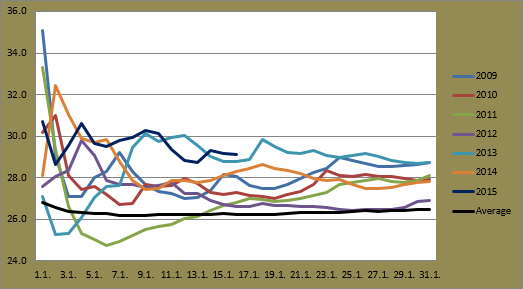In Jyväskylä, the yearly average minimum and maximum of 0.4C and 8.9C were the highest since at least 2009. 2009 to 2013 all recorded an average minimum at 0C or below. 2013's average maximum was also 8.9C, although lower than 2014 if we use two decimal places.
At a monthly level, only January, June and October had both minimum and maximum figures below the 1981-2010 averages. The graph below shows the averages for each month in 2014 while the dotted line represents the long term averages.
 |
| Monthly averages at Jyväskylä Airport in 2014 against the 1981-2010 averages |
As is typical, July was the warmest month in Jyväskylä in 2014. January took the title for the coldest month though ahead of the usual February. February and March saw figures well above the long term averages. In fact, Jyväskylä saw its second warmest February since at least 1961 in 2014, while March was the equal second warmest on record.
The hottest day of 2014 in Jyväskylä was July 25. It reached 30.3C at Tikkakoski then. Only one other day, July 26 with 30.2C, topped 30C, although two additional days, July 23 and 27, reached 29.9C. Since 2006, 2010 and 2013 were the only other years to record a temperature above 30C. The highest minimum was seen during the same period. July 31 didn't record a temperature lower than 15.3C. This was comparatively low to recent years though, with only 2009 recording a lower respective figure.
The coldest temperature of the year came during the coldest period of the year. It dropped to -27.7C on January 24. Only one other day, January 23, dropped below -25C. Again, only 2009 saw a lower figure with one below -25C. 2011 saw 16 days below the mark and 2010 saw 23. January 23 did, however, record the lowest daily maximum. The -16.1C figure was the warmest such figure in the years since 2009.
The highest temperature seen in Finland in 2014 was at Pori when it reached 32.8C on August 4. This is a fairly average figure. The coldest temperature was recorded in Utsjoki when it dropped to -40.7C on January 20, also a fairly normal figure.
The graph below shows the number of days with a temperature below -20C in Jyväskylä as well as the number of days above 25C. The year saw 35 days above 25C, the highest since at least 2009. 12 days below -20C was the lowest number though, giving support to the recording of the second highest average in Finland on record.
 |
| Number of days below -20C and above 25C at Jyväskylä Airport for the years 2009-2014 |
The next graph shows the daily minimums and maximums up against rainfall. After a couple of weeks at very cold temperatures in January, it is clear to see from the graph that February looks unusually warm. Minimums in March, and even in April, were colder. May saw a cool start to the changing seasons but temperatures exploded upwards on May 19 to 29.3C. Three days earlier on May 16 it was only as warm as 9.1C.
 |
| Daily temperatures against rainfall at Jyväskylä Airport in 2014 (Does not include February totals) |
Temperatures dropped in the second half of June, but climbed nicely in July. The summer season turned out to be quite a nice one with warm temperatures sticking around until the middle of August. September saw some unusually warm days. Five days of September topped 20C. Septembers from 2009 to 2013 recorded only six such days in total.
October saw a cold end to the month and included some of the lowest October minimums in a decade. Mild weather returned in November though and continued into the early part of December. It wasn't until December 22 that temperatures once again dropped below -10C.
Precipitation in 2014 at Tikkakoski was quite close to the 1981-2010 average. Based on my records, a total of 653.8mm fell. This total included a total from February of 25.0mm as recorded by the Finnish Meteorological Institute. This total was used because the FMI website did not show daily rainfall at Jyväskylä Airport during that month due to a technical fault. FMI records for 2014 show 613mm fell, substantially less than my recording. The average rainfall for a year is 643mm.
Four months of the year recorded above average rainfall, the other eight below. May was the wettest month. It saw 124.6mm, almost three times the long term average. May also included the wettest day of the year. May 26 saw 28.1mm fall. October 19 was the only other day to record a daily total above 25mm. There were six days with totals above 20mm.
 |
| Monthly rainfall totals at Jyväskylä Airport in 2014 against the 1981-2010 average |
January was the driest month. Only 16.8mm was recorded, just over one-third of the average. Much of that fell with temperatures above zero as well. Warmer days, coupled with dry conditions during colder weather, meant snow depths were among the lowest on record. The snow depth at Tikkakoski never went above 20cm during the whole 2013/14 winter.
The longest streak of precipitation came in December. The 17 days from the 5th to 17th recorded rain or snow. A total of 43.0mm was seen during that time. The longest dry streak was during the peak of the summer. July 17 to 27 saw no rain as temperatures soared above 25C during each day of that period.
In the end, it was a pretty decent year weatherwise for Jyväskylä. The small amount of snow and lack of colder temperatures during the winter months made for some grey and dreary sights, but the summer was especially enjoyable despite the cooler temperatures in June. A warm and mostly dry September also prolonged the warmer season somewhat. Snow at the end of year was welcomed by winter lovers as well.












